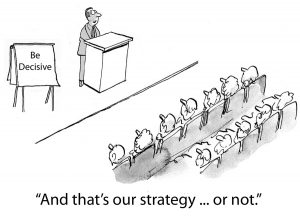Team Success Depends on Everyone
 WARNING! DON’T READ THIS WHILE YOU ARE HUNGRY! There are going to be a lot of food references here but they all have a point. It leads to what it can teach us about team success.
WARNING! DON’T READ THIS WHILE YOU ARE HUNGRY! There are going to be a lot of food references here but they all have a point. It leads to what it can teach us about team success.
You ever watch any of the cooking competition shows on television, like Iron Chef America? In that particular show, chef contestants are given the same set of ingredients and asked to make a meal. Not just a dish – a meal. Oftentimes, the ingredients they are given to use will seem totally mismatched with one another. Yet they are required to use each and every ingredient. They can add but they can’t subtract. A judging panel evaluates them on taste and how they incorporate everything.
Sometimes the chefs find it challenging incorporating all the ingredients into the meal. They may barely use one item and overuse another. And when that happens, they are marked down for it in the final result. The winners are usually the ones who effectively utilize each ingredient for optimum taste and contrast.
The Leader As Chef
In much the same way, as leaders we know that our greatest team success comes when we utilize everyone on the team. If we are lucky, we had a say in who exactly is on our team. We were able to hand pick them and choose them for the special talents and skills they can lend to the effort. It’s a beautiful thing when that happens.
On the other hand, more often than not we are like the Iron Chefs. We are given the team members and told to make something out of it. We might be able to add but we can’t subtract. So we have to figure out how each team member can best contribute to team goals. Our success depends on finding the right combination.
And it’s important that your team members understand that as well. The more they understand the importance of inclusion and the value of each team member, the better they can appreciate what each person brings to the table.
Potatoes and People
 Here’s a cool exercise you can use with your team or with a group of leaders to help them understand inclusion. I learned this with leader training we use for teaching Boy Scoutsto be effective leaders. Try this sometime as a lead-in to a meeting or as an exercise in a training session.
Here’s a cool exercise you can use with your team or with a group of leaders to help them understand inclusion. I learned this with leader training we use for teaching Boy Scoutsto be effective leaders. Try this sometime as a lead-in to a meeting or as an exercise in a training session.
- You are going to buy a bag of potatoes (or gather rocks) and call your team or company together.
- Hand each of them a potato (make a very solemn occasion of it. adds to the fun!)
- Send everyone off by themselves for a couple of minutes and tell them to get to know their potato. They want to examine their potato and notice all of its unique characteristics. Give it a name if they wish.
- When they gather back, you are going to ask each of them to introduce their potato to rest of the group. They can have a lot of fun with this – that’s all part of it. But they need to describe their potato as completely as they can, including its uniqueness.
- After everyone has introduced their potato to the group, collect all the potatoes back in a bag and then randomly redistribute them. Then challenge everyone to find their unique potato.
Using Both Diversity and Inclusion

Diversity is all about recognizing and celebrating the differences in each of us. No two potatoes are exactly alike; they have different shapes, different sizes, different textures and skin colors, and even the placement of the eyes. Yet each one is still a potato and still useful.
four ways to create your inclusive and productive team
- CONNECT WITH YOUR TEAM MEMBERS – As a leader, it’s very important that you connect with each person and get to know them well enough to understand their goals and their dreams. What do they see as their strengths? What do they like to do? What do they don’t like to do? Where do they see themselves fitting into the whole? Listen carefully! A lot of times they may very well be right. For this part, it is more important to listen than to talk.
- IDENTIFY STRENGTHS – Start with an assessment. There are lots of great ones out there, free and fee-based. If you’re not sure, give me a call and I’ll help. The important thing is you want to identify those strengths because that’s what we are looking to use. You don’t want to worry about weaknesses except in terms of how we can complement that.
- BUILD A STRENGTHS-BASED TEAM – Build your team based on the strengths of each person complementing the weaknesses of other team members. This is where the real Iron Chef leader comes out of you. You may find you need additional strengths you don’t have on your team. You may find you have too much of a particular strength. Still, you have to find a way to utilize all of it for optimum team success.
- FOSTER CONTINUOUS GROWTH – You want to build a mindset in your team for continuous growth and improvement of their strengths. Continuous personal growth allows them to take the strengths that they have and making them stronger. As a result, they will be more effective for the organization and happier. Your teams are going to be more cohesive, more productive, and you are going to see the results in your bottom-line.

 Have you ever let a pending decision freeze you? You know a choice has to be made. All of the options have pros and cons associated with them. You feel like EVERYTHING is hinging on this one decision you need to make. What do you do? The decisive leader knows how to make critical decisions and acts in the best interest of the team.
Have you ever let a pending decision freeze you? You know a choice has to be made. All of the options have pros and cons associated with them. You feel like EVERYTHING is hinging on this one decision you need to make. What do you do? The decisive leader knows how to make critical decisions and acts in the best interest of the team. Being a decisive leader doesn’t always mean that you are the only one who can decide. Don’t fall into that trap! It’s what ties even the most decisive person up in knots and can lead to poor decision making.
Being a decisive leader doesn’t always mean that you are the only one who can decide. Don’t fall into that trap! It’s what ties even the most decisive person up in knots and can lead to poor decision making. Before we talk about counsel keep in mind that every decision does not necessarily need to be made by you alone. The decisive leader knows when a collaborative or delegated decision is better than a command decision.
Before we talk about counsel keep in mind that every decision does not necessarily need to be made by you alone. The decisive leader knows when a collaborative or delegated decision is better than a command decision. One of the benefits of living in Central Florida is all the attractions around here. One of the attractions, of course, is
One of the benefits of living in Central Florida is all the attractions around here. One of the attractions, of course, is  You probably know someone who seems to always have it together. They are everywhere and in everything. To the naked eye they always seem to excel at everything they do.
You probably know someone who seems to always have it together. They are everywhere and in everything. To the naked eye they always seem to excel at everything they do.  In truth, the Law of Sacrifice is actually pretty simple. It’s all about priorities. Every single one of us has the same 24 hours in a day and seven days in a week. Barring
In truth, the Law of Sacrifice is actually pretty simple. It’s all about priorities. Every single one of us has the same 24 hours in a day and seven days in a week. Barring  We all do it. Folding laundry and watching TV. Driving and changing the radio station. Texting on your smartphone while talking to an employee. Sitting in a meeting and sending an email. Trying to do more than one thing at the same time because we don’t think there are enough hours in the day. It’s called Multitasking and it is the biggest time waster of all!
We all do it. Folding laundry and watching TV. Driving and changing the radio station. Texting on your smartphone while talking to an employee. Sitting in a meeting and sending an email. Trying to do more than one thing at the same time because we don’t think there are enough hours in the day. It’s called Multitasking and it is the biggest time waster of all! Further, understand that what you are doing is not actually multitasking.
Further, understand that what you are doing is not actually multitasking.  Get out a sheet of paper and lay it down so it is wider than it is high (landscape style).
Get out a sheet of paper and lay it down so it is wider than it is high (landscape style). On the next two lines you will do the same thing, again being timed.
On the next two lines you will do the same thing, again being timed.